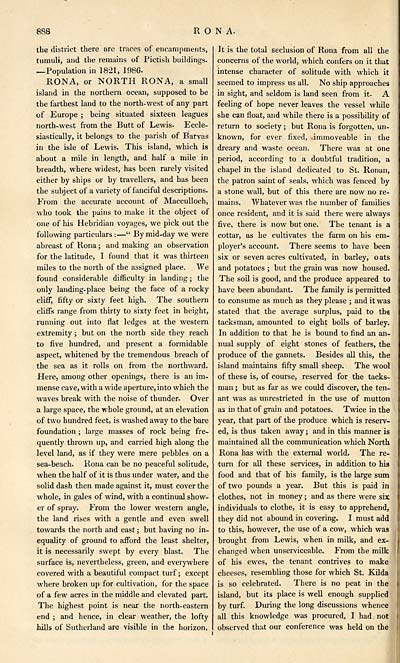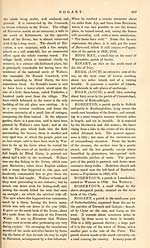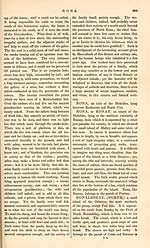Gazetteer of Scotland > Volume 2
(408) Page 888
Download files
Complete book:
Individual page:
Thumbnail gallery: Grid view | List view

ess
R O N A.
the district there arc traces of encampments,
tumuli, and the remains of Pictish buildings.
—Population in 1821, 1986-
RONA, or NORTH RONA, a small
island in the northern ocean, supposed to be
the farthest land to the north-west of any part
of Europe ; being situated sixteen leagues
north-west from the Butt of Lewis. Eccle-
siastically, it belongs to the parish of Barvas
in the isle of Lewis. This island, which is
about a mile in length, and half a mile in
breadth, where widest, has been rarely visited
either by ships or by travellers, and has been
the subject of a variety of fanciful descriptions.
From the accurate account of Macculloch,
who took the pains to make it the object of
one of his Hebridian voyages, we pick out the
following particulars : — " By mid-day we were
abreast of Rona ; and making an observation
for the latitude, I found that it was thirteen
miles to the north of the assigned place. We
found considerable difficulty in landing ; the
only landing-place being the face of a rocky
cliff, fifty or sixty feet high. The southern
cliffs range from thirty to sixty feet in height,
running out into fiat ledges at the western
extremity ; but on the north side they reach
to five hundred, and present a formidable
aspect, whitened by the tremendous breach of
the sea as it rolls on from the northward.
Here, among other openings, there is an im-
mense cave, with a wide aperture, into which the
waves break with the noise of thunder. Over
a large space, the whole ground, at an elevation
of two hundred feet, is washed away to the bare
foundation ; large masses of rock being fre-
quently thrown up, and carried high along the
level land, as if they were mere pebbles on a
sea-beach. Rona can be no peaceful solitude,
when the half of it is thus under water, and the
solid dash then made against it, must cover the
whole, in gales of wind, with a continual show-
er of spray. From the lower western angle,
the land rises with a gentle and even swell
towards the north and east ; but having no in-
equality of ground to afford the least shelter,
it is necessarily swept by every blast. The
surface is, nevertheless, green, and everywhere
covered with a beautiful compact turf ; except
where broken up for cultivation, for the space
of a few acres in the middle and elevated part.
The highest point is near the north-eastern
end ; and hence, in clear weather, the lofty
hills of Sutherland are visible in the horizon.
It is the total seclusion of Rona from all the
concerns of the world, which confers on it that
intense character of solitude with which it
seemed to impress us all. No ship approaches
in sight, and seldom is land seen from it. A
feeling of hope never leaves the vessel while
she can float, and while there is a possibility of
return to society ; but Rona is forgotten, un-
known, for ever fixed, .immoveable in the
dreary and waste ocean. There was at one
period, according to a doubtful tradition, a
chape] in the island dedicated to St. Ronan,
the patron saint of seals, which was fenced by
a stone wall, but of this there are now no re-
mains. Whatever was the number of families
once resident, and it is said there were always
five, there is now but one. The tenant is a
cottar, as he cultivates the farm on his em-
ployer's account. There seems to have been
six or seven acres cultivated, in barley, oats
and potatoes ; but the grain was now housed.
The soil is good, and the produce appeared to
have been abundant. The family is permitted
to consume as much as they please ; and it was
stated that the average surplus, paid to th«
tacksman, amounted to eight bolls of barley.
In addition to that he is bound to find an an-
nual supply of eight stones of feathers, the
produce of the gannets. Besides all this, the
island maintains fifty small sheep. The wool
of these is, of course, reserved for the tacks-
man ; but as far as we could discover, the ten-
ant was as unrestricted in the use of mutton
as in that of grain and potatoes. Twice in the
year, that part of the produce which is reserv-
ed, is thus taken away ; and in this manner is
maintained all the communication which North
Rona has with the external world. The re-
turn for all these services, in addition to his
food and that of his family, is the large sum
of two pounds a year. But this is paid in
clothes, not in money ; and as there were six
individuals to clothe, it is easy to apprehend,
they did not abound in covering. I must add
to this, however, the use of a cow, which was
brought from Lewis, when in milk, and ex-
changed when unserviceable. From the milk
of his ewes, the tenant contrives to make
cheeses, resembling those for which St. Kilda
is so celebrated. There is no peat in the
island, but its place is well enough supplied
by turf. During the long discussions whence
all this knowledge was procured, I had . not
observed that our conference was held on the
R O N A.
the district there arc traces of encampments,
tumuli, and the remains of Pictish buildings.
—Population in 1821, 1986-
RONA, or NORTH RONA, a small
island in the northern ocean, supposed to be
the farthest land to the north-west of any part
of Europe ; being situated sixteen leagues
north-west from the Butt of Lewis. Eccle-
siastically, it belongs to the parish of Barvas
in the isle of Lewis. This island, which is
about a mile in length, and half a mile in
breadth, where widest, has been rarely visited
either by ships or by travellers, and has been
the subject of a variety of fanciful descriptions.
From the accurate account of Macculloch,
who took the pains to make it the object of
one of his Hebridian voyages, we pick out the
following particulars : — " By mid-day we were
abreast of Rona ; and making an observation
for the latitude, I found that it was thirteen
miles to the north of the assigned place. We
found considerable difficulty in landing ; the
only landing-place being the face of a rocky
cliff, fifty or sixty feet high. The southern
cliffs range from thirty to sixty feet in height,
running out into fiat ledges at the western
extremity ; but on the north side they reach
to five hundred, and present a formidable
aspect, whitened by the tremendous breach of
the sea as it rolls on from the northward.
Here, among other openings, there is an im-
mense cave, with a wide aperture, into which the
waves break with the noise of thunder. Over
a large space, the whole ground, at an elevation
of two hundred feet, is washed away to the bare
foundation ; large masses of rock being fre-
quently thrown up, and carried high along the
level land, as if they were mere pebbles on a
sea-beach. Rona can be no peaceful solitude,
when the half of it is thus under water, and the
solid dash then made against it, must cover the
whole, in gales of wind, with a continual show-
er of spray. From the lower western angle,
the land rises with a gentle and even swell
towards the north and east ; but having no in-
equality of ground to afford the least shelter,
it is necessarily swept by every blast. The
surface is, nevertheless, green, and everywhere
covered with a beautiful compact turf ; except
where broken up for cultivation, for the space
of a few acres in the middle and elevated part.
The highest point is near the north-eastern
end ; and hence, in clear weather, the lofty
hills of Sutherland are visible in the horizon.
It is the total seclusion of Rona from all the
concerns of the world, which confers on it that
intense character of solitude with which it
seemed to impress us all. No ship approaches
in sight, and seldom is land seen from it. A
feeling of hope never leaves the vessel while
she can float, and while there is a possibility of
return to society ; but Rona is forgotten, un-
known, for ever fixed, .immoveable in the
dreary and waste ocean. There was at one
period, according to a doubtful tradition, a
chape] in the island dedicated to St. Ronan,
the patron saint of seals, which was fenced by
a stone wall, but of this there are now no re-
mains. Whatever was the number of families
once resident, and it is said there were always
five, there is now but one. The tenant is a
cottar, as he cultivates the farm on his em-
ployer's account. There seems to have been
six or seven acres cultivated, in barley, oats
and potatoes ; but the grain was now housed.
The soil is good, and the produce appeared to
have been abundant. The family is permitted
to consume as much as they please ; and it was
stated that the average surplus, paid to th«
tacksman, amounted to eight bolls of barley.
In addition to that he is bound to find an an-
nual supply of eight stones of feathers, the
produce of the gannets. Besides all this, the
island maintains fifty small sheep. The wool
of these is, of course, reserved for the tacks-
man ; but as far as we could discover, the ten-
ant was as unrestricted in the use of mutton
as in that of grain and potatoes. Twice in the
year, that part of the produce which is reserv-
ed, is thus taken away ; and in this manner is
maintained all the communication which North
Rona has with the external world. The re-
turn for all these services, in addition to his
food and that of his family, is the large sum
of two pounds a year. But this is paid in
clothes, not in money ; and as there were six
individuals to clothe, it is easy to apprehend,
they did not abound in covering. I must add
to this, however, the use of a cow, which was
brought from Lewis, when in milk, and ex-
changed when unserviceable. From the milk
of his ewes, the tenant contrives to make
cheeses, resembling those for which St. Kilda
is so celebrated. There is no peat in the
island, but its place is well enough supplied
by turf. During the long discussions whence
all this knowledge was procured, I had . not
observed that our conference was held on the
Set display mode to: Large image | Transcription
Images and transcriptions on this page, including medium image downloads, may be used under the Creative Commons Attribution 4.0 International Licence unless otherwise stated. ![]()
| Gazetteers of Scotland, 1803-1901 > Gazetteer of Scotland > Volume 2 > (408) Page 888 |
|---|
| Permanent URL | https://digital.nls.uk/97435718 |
|---|
| Description | Volume II: Glenbanchor to Zetland. |
|---|---|
| Attribution and copyright: |
|
| Description | By Robert Chambers and William Chambers. Glasgow: Blackie & Son, 1838. 2 volumes. |
|---|---|
| Shelfmark | NF.1461.g.7 |
| Additional NLS resources: | |

